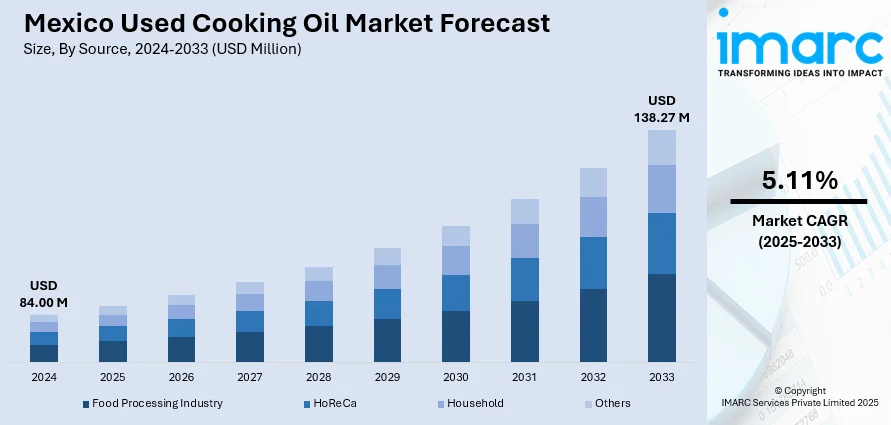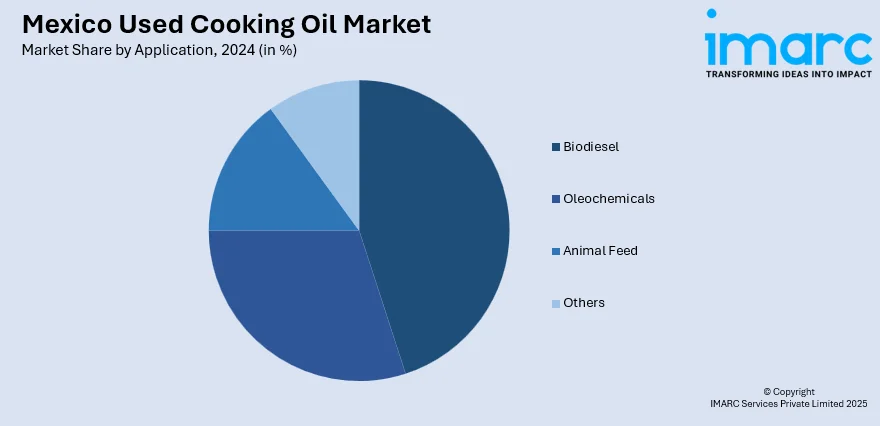
Mexico Used Cooking Oil Market Size, Share, Trends and Forecast by Source, Application, and Region, 2025-2033
Mexico Used Cooking Oil Market Overview:
The Mexico used cooking oil market size reached USD 84.00 Million in 2024. The market is projected to reach USD 138.27 Million by 2033, exhibiting a growth rate (CAGR) of 5.11% during 2025-2033. In Mexico, food establishments continue to rely heavily on deep-frying and repeated oil utilization, resulting in substantial quantities of used cooking oil. Environmental agencies are promoting initiatives that discourage the improper disposal of used cooking oil, thereby channeling it towards energy production. Besides this, the broadening of retail channels is contributing to the expansion of the Mexico used cooking oil market share.
|
Report Attribute
|
Key Statistics
|
|---|---|
|
Base Year
|
2024
|
|
Forecast Years
|
2025-2033
|
|
Historical Years
|
2019-2024
|
| Market Size in 2024 | USD 84.00 Million |
| Market Forecast in 2033 | USD 138.27 Million |
| Market Growth Rate 2025-2033 | 5.11% |
Mexico Used Cooking Oil Market Trends:
Growing emphasis on renewable energy
The government's increasing focus on renewable energy is offering a favorable market outlook in Mexico. As the country is working towards achieving its energy transition goals and reducing dependence on fossil fuels, there is a growing emphasis on biofuel development, where used cooking oil serves as a vital feedstock. As per the IMARC Group, the Mexico biofuel market size reached USD 1.19 Billion in 2024. Public policies and sustainability frameworks are encouraging the adoption of cleaner energy sources. Used cooking oil is being advocated as a low-carbon option for biodiesel manufacturing. This transition is leading to investments in infrastructure for the collection, purification, and conversion of waste oil. Programs backed by the government are facilitating partnerships between the public and private sectors to enhance the recycling of used cooking oil from homes and food producers. Environmental organizations are further promoting programs that prevent the incorrect disposal of used cooking oil. These efforts are creating new revenue streams for businesses involved in the collection and processing of used cooking oil. Moreover, Mexico’s commitment to international climate agreements has further strengthened regulatory and fiscal support for bioenergy ventures. As a result, used cooking oil is being viewed as a strategic resource in the country’s broader renewable energy roadmap.

To get more information on this market, Request Sample
Expansion of restaurant and fast-food chains
The broadening of restaurant and fast-food chains is impelling the Mexico used cooking oil market growth. In Mexico, 7,23,285 economic units were registered by restaurants and other eating establishments, according to DENUE 2024. As the demand for convenient food options is rising, more quick-service restaurants (QSRs) and dine-in chains are emerging across major cities and towns. These food establishments rely heavily on deep-frying and repeated oil utilization, resulting in substantial quantities of used cooking oil. To comply with environmental regulations and improve sustainability practices, many of these outlets are partnering with collection services to dispose of used cooking oil efficiently. Additionally, the growing awareness within the foodservice industry about responsible waste management is motivating restaurants to monetize waste oil, creating a commercial incentive that is strengthening the market infrastructure in Mexico.
Improved logistics
Improved logistics are streamlining the collection, transportation, and processing of used cooking oil across urban and rural areas. Retail expansion in urban centers is increasing the volume of food preparation, leading to greater availability of used cooking oil for collection and reutilization. In Mexico, retail sales grew by 7.1% in 2024, as reported by the National Association of Supermarkets and Department Stores (ANTAD). Enhanced storage facilities and transport systems ensure the oil is moved safely and hygienically to processing centers without contamination. Logistics advancements also aid in reducing operational costs, making the overall recycling and biofuel conversion process more profitable. Real-time tracking, route optimization, and dedicated fleets are improving service reliability and expanding the market access.
Mexico Used Cooking Oil Market Segmentation:
IMARC Group provides an analysis of the key trends in each segment of the market, along with forecasts at the country and regional levels for 2025-2033. Our report has categorized the market based on source and application.
Source Insights:
- Food Processing Industry
- HoReCa
- Household
- Others
The report has provided a detailed breakup and analysis of the market based on the source. This includes food processing industry, HoReCa, household, and others.
Application Insights:

- Biodiesel
- Oleochemicals
- Animal Feed
- Others
A detailed breakup and analysis of the market based on the application have also been provided in the report. This includes biodiesel, oleochemicals, animal feed, and others.
Regional Insights:
- Northern Mexico
- Central Mexico
- Southern Mexico
- Others
The report has also provided a comprehensive analysis of all the major regional markets, which include Northern Mexico, Central Mexico, Southern Mexico, and others.
Competitive Landscape:
The market research report has also provided a comprehensive analysis of the competitive landscape. Competitive analysis such as market structure, key player positioning, top winning strategies, competitive dashboard, and company evaluation quadrant has been covered in the report. Also, detailed profiles of all major companies have been provided.
Mexico Used Cooking Oil Market Report Coverage:
| Report Features | Details |
|---|---|
| Base Year of the Analysis | 2024 |
| Historical Period | 2019-2024 |
| Forecast Period | 2025-2033 |
| Units | Million USD |
| Scope of the Report |
Exploration of Historical Trends and Market Outlook, Industry Catalysts and Challenges, Segment-Wise Historical and Future Market Assessment:
|
| Sources Covered | Food Processing Industry, HoReCa, Household, Others |
| Applications Covered | Biodiesel, Oleochemicals, Animal feed, Others |
| Regions Covered | Northern Mexico, Central Mexico, Southern Mexico, Others |
| Customization Scope | 10% Free Customization |
| Post-Sale Analyst Support | 10-12 Weeks |
| Delivery Format | PDF and Excel through Email (We can also provide the editable version of the report in PPT/Word format on special request) |
Key Questions Answered in This Report:
- How has the Mexico used cooking oil market performed so far and how will it perform in the coming years?
- What is the breakup of the Mexico used cooking oil market on the basis of source?
- What is the breakup of the Mexico used cooking oil market on the basis of application?
- What is the breakup of the Mexico used cooking oil market on the basis of region?
- What are the various stages in the value chain of the Mexico used cooking oil market?
- What are the key driving factors and challenges in the Mexico used cooking oil market?
- What is the structure of the Mexico used cooking oil market and who are the key players?
- What is the degree of competition in the Mexico used cooking oil market?
Key Benefits for Stakeholders:
- IMARC’s industry report offers a comprehensive quantitative analysis of various market segments, historical and current market trends, market forecasts, and dynamics of the Mexico used cooking oil market from 2019-2033.
- The research report provides the latest information on the market drivers, challenges, and opportunities in the Mexico used cooking oil market.
- Porter's five forces analysis assist stakeholders in assessing the impact of new entrants, competitive rivalry, supplier power, buyer power, and the threat of substitution. It helps stakeholders to analyze the level of competition within the Mexico used cooking oil industry and its attractiveness.
- Competitive landscape allows stakeholders to understand their competitive environment and provides an insight into the current positions of key players in the market.
Need more help?
- Speak to our experienced analysts for insights on the current market scenarios.
- Include additional segments and countries to customize the report as per your requirement.
- Gain an unparalleled competitive advantage in your domain by understanding how to utilize the report and positively impacting your operations and revenue.
- For further assistance, please connect with our analysts.
 Request Customization
Request Customization
 Speak to an Analyst
Speak to an Analyst
 Request Brochure
Request Brochure
 Inquire Before Buying
Inquire Before Buying




.webp)




.webp)












